
Giovanni Bellini was an Italian Renaissance painter, probably the best known of the Bellini family of Venetian painters. He was raised in the household of Jacopo Bellini, formerly thought to have been his father, but now that familial generational relationship is questioned. An older brother, Gentile Bellini was more highly regarded than Giovanni during his lifetime, but the reverse is true today. His brother-in-law was Andrea Mantegna.
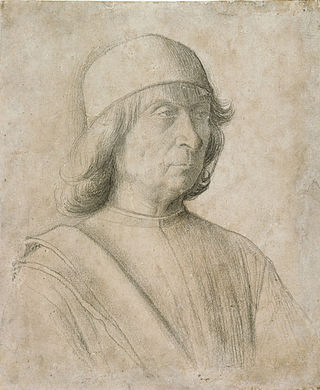
Gentile Bellini was an Italian painter of the school of Venice. He came from Venice's leading family of painters, and at least in the early part of his career was more highly regarded than his younger brother Giovanni Bellini, the reverse of the case today. From 1474 he was the official portrait artist for the Doges of Venice, and as well as his portraits he painted a number of very large subjects with multitudes of figures, especially for the Scuole Grandi of Venice, wealthy confraternities that were very important in Venetian patrician social life.

Jacopo Bellini was one of the founders of the Renaissance style of painting in Venice and northern Italy. His sons Gentile and Giovanni Bellini, and his son-in-law Andrea Mantegna, were also famous painters.

Antonello da Messina, properly Antonello di Giovanni di Antonio, but also called Antonello degli Antoni and Anglicized as Anthony of Messina, was an Italian painter from Messina, active during the Italian Early Renaissance.
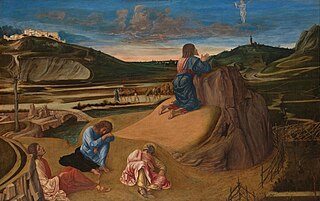
The Agony in the Garden is an early painting by the Italian Renaissance master Giovanni Bellini, who created it ca.1459–1465. It is a tempera painting on panel and is now in the National Gallery, London.

Crucifixion is a painting by the Italian Renaissance painter Giovanni Bellini, created around 1455–1460. It is housed in the Museo Correr in Venice.

The Four Allegories is a series of four small panel paintings in the Gallerie dell'Accademia, Venice, Italy by the Italian Renaissance master Giovanni Bellini, whose date has been variously argued as different points in the range 1490–1504. They all measure 34 (Perseverance) or 32 × 22 cm in size.

The Annunciation of San Giovanni Valdarno is a painting by the Italian Early Renaissance master Fra Angelico, painted c. 1430 to 1432 in tempera on panel. It is part of a series of Annunciation panels painted by Fra Angelico in the 1430s. The other two are the Annunciation of Cortona and the Annunciation.

Madonna with Child between Saints Flavian and Onuphrius is an oil-on-panel painting by Lorenzo Lotto, signed and dated 1508, now in the Borghese Gallery, in Rome.
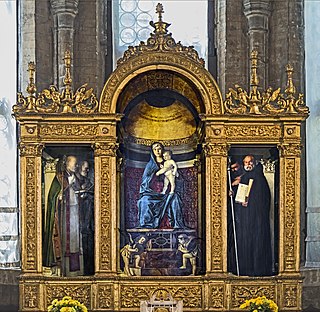
The Frari Triptych or Pesaro Triptych is a 1488 oil-on-panel triptych painting by the Italian Renaissance master Giovanni Bellini. It is signed and dated 1488 on the centre of the Virgin Mary's throne, though it may have taken several years to produce, meaning he started it in 1485. On the reverse is a label dating its completion more precisely, to 15 February 1488. It is in the basilica di Santa Maria Gloriosa dei Frari in Venice.

Pietà is a tempera-on-panel painting executed c.1455–1460 by the Italian Renaissance artist Giovanni Bellini, now in the Museo Poldi Pezzoli in Milan. One of his earliest works, it is the prototype for his long series of other Pietas such as Pietà (Bergamo).

Christ Blessing is a tempera-on-panel painting by the Italian artist Giovanni Bellini. It is usually dated to the early 1460s, that is, in the middle of Bellini's Mantegnese phase. It is now in the Louvre in Paris.

The Frizzoni Madonna is a 1460–1464 painting by the Italian Renaissance painter Giovanni Bellini. It was once part of the Frizzoni collection in Bergamo. It entered the Museo Correr in Venice in 1891, the same year as it was identified as a work by Bellini. It was originally an oil-on-wood painting, but it was transferred to canvas before entering the Museo Correr.

Madonna and Child is a c.1475 tempera-on-panel painting by the Italian Renaissance artist Giovanni Bellini, now in the Museo di Castelvecchio in Verona. It measures 77 cm by 57 cm.

Nunc Dimittis or Sacred Conversation is an oil-on-panel painting created ca. 1505–1510 by the Italian Renaissance master Giovanni Bellini. It measures 62 cm by 83 cm and is now in the Museo Thyssen-Bornemisza in Madrid. It belongs to the sacra conversazione genre and shows Anna and Simeon with the Madonna and Child.
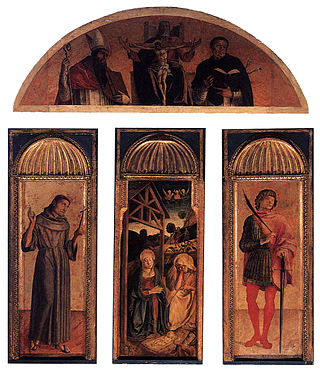
The Nativity Triptych is a 1464–1470 tempera-on-panel altarpiece by the Italian Renaissance painter Giovanni Bellini and others, now in the Gallerie dell'Accademia in Venice. Its central panel of the Nativity measures 127 by 48 cm, its lunette of the Holy Trinity flanked by Augustine and Dominic 59 by 170 cm and its side panels of Francis of Assisi and Victor 103 by 45 cm.
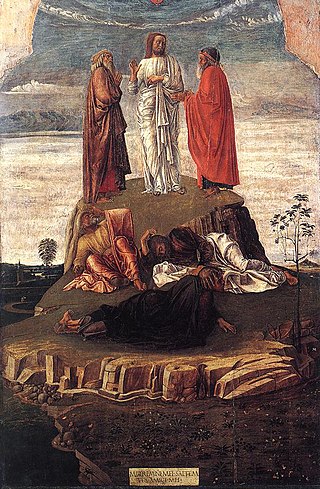
The Transfiguration is a tempera-on-panel painting by Italian painter Giovanni Bellini, created c. 1454–1460. It depicts the Gospel episode the Transfiguration of Jesus. It is held in the Museo Correr in Venice.
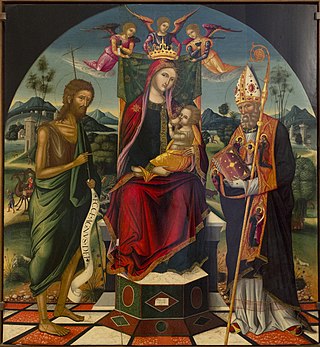
Madonna and Child enthroned with St. John the Baptist and St. Augustine is an oil painting by Greek painter Ioannis Permeniates. He was from Crete living in Venice. He was active during the first part of the 16th century. There are dozens of works attributed to the artist. He is a cross-over artist who painted in both the maniera greca and the Venetian style. Other similar artists were El Greco and Michael Damaskinos. Ioannis Permeniates's work was influenced by Vittore Carpaccio and Giovanni Bellini. His most notable painting is the Madonna and Child enthroned with St. John the Baptist and St. Augustine. Many Italian artists painted the same subject matter. The most famous painting depicting the subjects is the Madonna and Child with St John the Baptist and St Augustine by Petrus Perusinus. The Permeniates is part of the collection Museo Correr in Venice, Italy.

Madonna and Child is an oil-on-panel painting created in 1504 by the Italian Renaissance painter Cima da Conegliano, now in the Museo nazionale atestino in Este. It is the most important pictorial work in the museum, which is mainly dedicated to archeology.



















